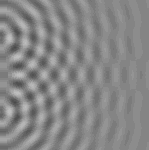Experiments on Wave Interference
 I've heard scientists refer to "bizarre quantum behavior." What do they
mean?
I've heard scientists refer to "bizarre quantum behavior." What do they
mean?
|
 When we look at matter on an extremely tiny scale, we see surprising behavior
we call "quantum." It strikes us as bizarre because it is so different from
our everyday experience. A famous physicist named Richard Feynman felt that
all the strangeness of quantum behavior can be seen in one simple and elegant
experiment called the "Two Slit Experiment."
When we look at matter on an extremely tiny scale, we see surprising behavior
we call "quantum." It strikes us as bizarre because it is so different from
our everyday experience. A famous physicist named Richard Feynman felt that
all the strangeness of quantum behavior can be seen in one simple and elegant
experiment called the "Two Slit Experiment."
|
 Oh, we got to do that in science class. That's where you shine a laser through
two tiny slits and it makes a pattern on the wall. What's so weird about
that?
Oh, we got to do that in science class. That's where you shine a laser through
two tiny slits and it makes a pattern on the wall. What's so weird about
that?
 Let's start with what you remember about that experiment.
Let's start with what you remember about that experiment.
|
 Well, we talked about how light travels in waves, and waves can "cancel each
other out" if the high point of one meets the low point of another.
Well, we talked about how light travels in waves, and waves can "cancel each
other out" if the high point of one meets the low point of another.
|
Adding WavesTry changing the amplitude and frequency of the top two waves by dragging the gray ball around. You can also slide the whole wave back and forth by clicking and dragging anywhere except on the gray ball. The graph at the bottom right shows the relation between the two waves. You can modify the waves by dragging the balls around on the graph. |
 Right, or they can amplify each other if two high points (crests) or
two low points (troughs) happen to meet.
Right, or they can amplify each other if two high points (crests) or
two low points (troughs) happen to meet.
 And when the light passes through each slit, it spreads out like ripples on a
pond, and when the ripples from one slit meet the ripples from another slit,
they "amplify" and "cancel" each other.
And when the light passes through each slit, it spreads out like ripples on a
pond, and when the ripples from one slit meet the ripples from another slit,
they "amplify" and "cancel" each other.
 Your pond analogy is a good one, because the same thing would happen on the
surface of water, say if there were two holes in a breakwater that waves could
get through. Let's take a peek at what that would look like. The image below
shows two radiating waves interfering with each other. The bright areas are
peaks, and the dark areas are troughs.
Your pond analogy is a good one, because the same thing would happen on the
surface of water, say if there were two holes in a breakwater that waves could
get through. Let's take a peek at what that would look like. The image below
shows two radiating waves interfering with each other. The bright areas are
peaks, and the dark areas are troughs.

|
Interfering WavesDark Areas = Troughs (valleys)Light Areas = Crests (peaks)
Large Movie (fast computers) |
 Oh, I can see where the waves are acting to amplify and cancel each other by
the dark and light areas. It doesn't look random, either. There's some pattern
to it.
Oh, I can see where the waves are acting to amplify and cancel each other by
the dark and light areas. It doesn't look random, either. There's some pattern
to it.
|
 Light behaves basically the same way as water waves, but it's harder to
visualize because it's happening in three dimensions, and you can't see the
light until it hits something.
Light behaves basically the same way as water waves, but it's harder to
visualize because it's happening in three dimensions, and you can't see the
light until it hits something.
|
 Like the experiment we did in school.
Like the experiment we did in school.
|
 Exactly. So let's take a look at that experiment...
Exactly. So let's take a look at that experiment...
|





